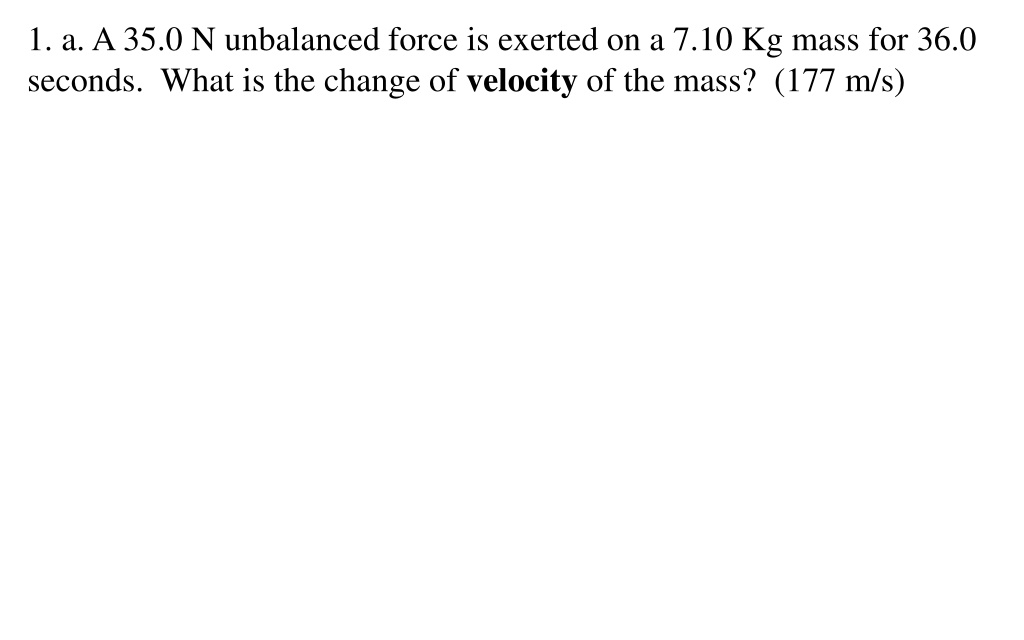
Physics Problems on Force, Mass, and Velocity
Solve physics problems involving unbalanced forces, changes in velocity, and thrust calculations. Topics include force exertion on masses, baseball collisions, rocket propulsion, and more. Enhance your understanding of physics concepts with these practical examples and solutions.
Download Presentation

Please find below an Image/Link to download the presentation.
The content on the website is provided AS IS for your information and personal use only. It may not be sold, licensed, or shared on other websites without obtaining consent from the author. If you encounter any issues during the download, it is possible that the publisher has removed the file from their server.
You are allowed to download the files provided on this website for personal or commercial use, subject to the condition that they are used lawfully. All files are the property of their respective owners.
The content on the website is provided AS IS for your information and personal use only. It may not be sold, licensed, or shared on other websites without obtaining consent from the author.
E N D
Presentation Transcript
1. a. A 35.0 N unbalanced force is exerted on a 7.10 Kg mass for 36.0 seconds. What is the change of velocity of the mass? (177 m/s)
b. A 0.145 Kg baseball going 41.0 m/s, strikes a bat, and heads straight back to the outfield at 31.0 m/s. If the bat exerted a force of 2530 N, for what time was it in contact with the bat? (0.00413 s)
c. A rocket burns 42.4 kg in 6.50 s with an exhaust velocity of 720. m/s. What is the thrust of the engine? (4697 N)
d. A rocket engine burns fuel at a rate of 4.10 grams per second, and develops a force of 12.2 N. What must be the exhaust velocity? (1000 grams = 1 kg) (2976 m/s)
e. A 114 kg rocket (total mass of fuel and rocket), burns 95.0 kg of fuel at a rate of 3.50 kg/s with an exhaust velocity of 790. m/s. What are its initial and final acceleration as it takes off from earth? (14.5 m/s/s, 136 m/s/s)
2. a. A 62.0 N unbalanced force is exerted on an object for 4.5 seconds. The mass changes velocity from rest to 47 m/s. What is the mass of the object? (5.94 kg)
b. A 0.138 Kg baseball going 37.0 m/s, strikes a bat, and heads straight back to the outfield at 45.0 m/s. If the collision lasted for .0121 seconds, what force did the bat exert on the baseball? (935 N)
c. A rocket engine develops 1240 N of thrust burning 56.2 kg of fuel in 21.5 s. What is the exhaust velocity? (474 m/s)
d. A rocket engine burns fuel at a rate of 1.40 grams per second, and has an exhaust velocity of 890. m/s. What thrust does it develop? (1000 grams = 1 kg) (1.25 N)
e. A 324 kg rocket, 292 kg of which is fuel, burns all of its fuel in 38.0 seconds with an exhaust velocity of 880. m/s. What are its initial and final acceleration as it takes off from earth? (11.1 m/s/s, 202 m/s/s)
3. a. A force is exerted on a 23 Kg mass for 15 seconds. The mass changes velocity from rest to 45 m/s. What was the force? (69.0 N)
b. A ball going 27.0 m/s, strikes a bat, and heads straight back to the outfield at 41.0 m/s. If the bat exerted a force of 312 N for 0.0230 seconds, what is the mass of the ball? (0.106 kg)
c. A rocket burns 35.1 kg of fuel generating 450. N of thrust with an exhaust velocity of 790. m/s. What time do the engines burn? (61.6 s)
d. A rocket develops a thrust of 14.2 N, with an exhaust velocity of 910. m/s. What mass in fuel does the engine burn every second? (0.0156 kg/s or 15.6 g/s)
e. A 67.0 kg rocket (total mass of fuel and rocket), burns 52.0 kg of fuel at a rate of 2.70 kg/s with an exhaust velocity of 642 m/s. What are its initial and final acceleration as it takes off from earth? (16.1 m/s/s, 106 m/s/s)
